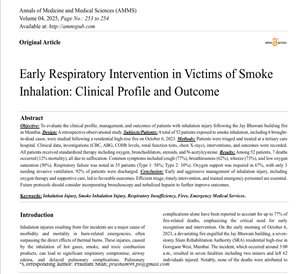Early Respiratory Intervention in Victims of Smoke Inhalation: Clinical Profile and Outcome
Authors
##plugins.themes.bootstrap3.article.main##
Abstract
Objective: To evaluate the clinical profile, management, and outcomes of patients with inhalation injury following the Jay Bhawani building fire in Mumbai. Design: A retrospective observational study. Subjects/Patients: A total of 52 patients exposed to smoke inhalation, including 6 brought-in-dead cases, were studied following a residential high-rise fire on October 6, 2023. Methods: Patients were triaged and treated at a tertiary care hospital. Clinical data, investigations (CBC, ABG, COHb levels, renal function tests, chest X-rays), interventions, and outcomes were recorded. All patients received standardized therapy including oxygen, bronchodilators, steroids, and N-acetylcysteine. Results: Among 52 patients, 7 deaths occurred (12% mortality), all due to suffocation. Common symptoms included cough (77%), breathlessness (62%), wheeze (73%), and low oxygen saturation (50%). Respiratory failure was noted in 35 patients (Type 1: 58%; Type 2: 10%). Oxygen support was required in 67%, with only 3 needing invasive ventilation. 92% of patients were discharged. Conclusion: Early and aggressive management of inhalation injury, including oxygen therapy and supportive care, led to favorable outcomes. Efficient triage, timely intervention, and trained emergency personnel are essential. Future protocols should consider incorporating bronchoscopy and nebulized heparin to further improve outcomes.
##plugins.themes.bootstrap3.article.details##
Copyright (c) 2025 Neelam Redkar, Prakash R Relwani, Sanjay W Gulhane, Sameer S Yadav, Anuj Tiwari, Prasham Shah, Kaustubh Sonawane, Mukund Upadhyay, Raed A. Kalsekar, Alhad A. Mulkalwar

This work is licensed under a Creative Commons Attribution 4.0 International License.
Creative Commons License All articles published in Annals of Medicine and Medical Sciences are licensed under a Creative Commons Attribution 4.0 International License.
[1] Ryan CM, Schoenfeld DA, Thorpe WP, Sheridan RL, Cassem EH, Tompkins RG. Objective estimates of the probability of death from burn injuries. N Engl J Med. 1998 Feb 5;338(6):362-6. doi: 10.1056/NEJM199802053380604.
[2] Dyamenahalli K, Garg G, Shupp JW, Kuprys PV, Choudhry MA, Kovacs EJ. Inhalation Injury: Unmet Clinical Needs and Future Research. J Burn Care Res. 2019 Aug 14;40(5):570-584. doi: 10.1093/jbcr/irz055.
[3] Gupta K, Mehrotra M, Kumar P, Gogia AR, Prasad A, Fisher JA. Smoke Inhalation Injury: Etiopathogenesis, Diagnosis, and Management. Indian J Crit Care Med. 2018 Mar;22(3):180-188. doi: 10.4103/ijccm.IJCCM_460_17.
[4] Galeiras R. Smoke inhalation injury: a narrative review. Mediastinum. 2021 Jun 25;5:16. doi: 10.21037/med-21-7.
[5] Lan X, Huang Z, Tan Z, Huang Z, Wang D, Huang Y. Nebulized heparin for inhalation injury in burn patients: a systematic review and meta-analysis. Burns Trauma. 2020 Jun 4;8:tkaa015. doi: 10.1093/burnst/tkaa015.
[6] Desai MH, Mlcak R, Richardson J, Nichols R, Herndon DN. Reduction in mortality in pediatric patients with inhalation injury with aerosolized heparin/N-acetylcystine [correction of acetylcystine] therapy. J Burn Care Rehabil. 1998 May-Jun;19(3):210-2. doi: 10.1097/00004630-199805000-00004.
[7] Woodson CL. Diagnosis and treatment of inhalation injury. In: Total Burn Care, 4 ed, Herndon DN (Ed), 2009
[8] Mlcak RP, Hegde SD, Herndon DN. Respiratory Care. In: Total Burn Care, 4th ed, Herndon DN (Ed), Saunders Elsevier, Philadelphia 2012.

